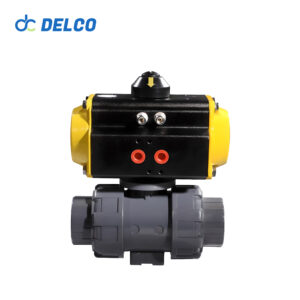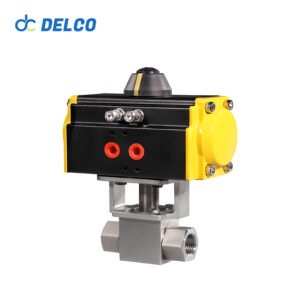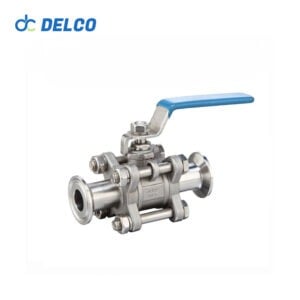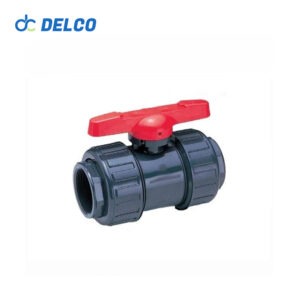Não nos limitamos a fornecer simples orçamentos, mas somos especialistas em seleção, cálculo e desenho.
As melhores escolhas
DELCO Valve 3 Way Mixing Diverting Electric Control Valves
The electric 3-way control valve is composed of three ZDLQ/X series electric actuators and a three-way control mechanism. Electric actuator in a servo system, no need of a servo amplifier, have spread into the signal and power source control operation, simple wiring. Adjusting mechanism is combined and split two ways, can replace the two-valve and a three-way pipe has been widely used in some occasions. Two commonly used in the heat exchangers and regulation of simple ratio regulation.
Modelo: ZDLQ/X
Gama de tamanhos: 1/2” to 12”
Gama de pressão: 1.6 to 6.4 MPa
Material: Stainless Steel 304/316, WCB
DELCO Cast Steel Electric Actuator Globe Control Valve Introduction:
The 3-way electric control valve offers two action types: electric mixing (converging) control valve and electric diverting (diverging) control valve. This valve system comprises the PSL series and 3810 series linear electric actuators, combined with a 3-way valve body. The electric actuator features an integrated electronic structure with a built-in servo amplifier. By receiving input control signals (4-20mADC or 1-5VDC) and power supply, it controls the valve opening to regulate parameters such as pressure, flow, liquid level, and temperature.
The electric 3-way mixing control valve is primarily utilized for blending two fluids into a third fluid, while the 3-way diverging electric control valve is mainly employed for splitting one fluid into two separate fluids.
Technical Specifications of Valve Actuator:
| DN | 25 | 32 | 40 | 50 | 65 | 80 | 100 | 125 | 150 | 200 | 250 | 300 |
| Seat diameter mm | 25 | 32 | 40 | 50 | 65 | 80 | 100 | 125 | 150 | 200 | 250 | 300 |
| Rated KV | 8.5 | 13 | 21 | 34 | 53 | 85 | 135 | 210 | 340 | 535 | 800 | 1280 |
| Nominal pressure (MPa) | 1.6,2.5,4.0,6.4 | |||||||||||
| Trip(mm) | 16 | 25 | 40 | 60 | 100 | |||||||
| With electric actuator model | 361LSA-20 | 361LSB-30 | 361LSB-50 | 361LSB-65 | 361LSB-99 | |||||||
| Input signal | 4-20mADC,1-5VDC | |||||||||||
| Power Supply | AC220V 50HZ | |||||||||||
| The inherent flow characteristics | Linear, equal percentage, quick opening | |||||||||||
| The inherent modulation ratio | 30:01:00 | |||||||||||
| The inherent modulation ratio | IV | |||||||||||
| Flange size | According to JB/79.1 (2) -94, HG20592-97, GB, ANSI, JIS, DIN and other standards | |||||||||||
| Material da carroçaria | WCB, 304, 316, WC6, nickel, titanium, Hastelloy, Monel etc. | |||||||||||
| Valve material | 304, 316, 420, nickel, titanium, Hastelloy, Monel etc. | |||||||||||
| Working temperature ℃ | -40~230 | |||||||||||
| Series type | At room temperature, medium temperature type, bellows seal type | |||||||||||
Technical Specifications of Valve Actuator:
The versatility of electrical 3-way control valves makes them indispensable in a wide range of industrial and commercial applications. Some common applications include.
- HVAC Systems: These valves are used in heating, ventilation, and air conditioning systems to control the flow of hot and cold water, ensuring precise temperature regulation in buildings and facilities.
- Process Control: In industrial processes such as chemical manufacturing, pharmaceutical production, and food processing, 3-way control valves play a vital role in controlling the flow of liquids, gases, and steam to achieve optimal process conditions and product quality.
- Water Treatment: Electrical 3-way control valves are employed in water treatment plants to regulate the flow of chemicals, control pH levels, and manage the mixing of different water streams for purification and disinfection purposes.
- Renewable Energy Systems: In renewable energy systems such as solar thermal and geothermal power plants, these valves help regulate the flow of heat transfer fluids to optimize energy capture and conversion processes.

Obtenha um orçamento rápido
RECOMENDAR











